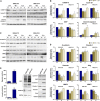O-GlcNAc-induced nuclear translocation of hnRNP-K is associated with progression and metastasis of cholangiocarcinoma
- PMID: 30444036
- PMCID: PMC6360360
- DOI: 10.1002/1878-0261.12406
O-GlcNAc-induced nuclear translocation of hnRNP-K is associated with progression and metastasis of cholangiocarcinoma
Abstract
O-GlcNAcylation is a key post-translational modification that modifies the functions of proteins. Associations between O-GlcNAcylation, shorter survival of cholangiocarcinoma (CCA) patients, and increased migration/invasion of CCA cell lines have been reported. However, the specific O-GlcNAcylated proteins (OGPs) that participate in promotion of CCA progression are poorly understood. OGPs were isolated from human CCA cell lines, KKU-213 and KKU-214, using a click chemistry-based enzymatic labeling system, identified using LC-MS/MS, and searched against an OGP database. From the proteomic analysis, a total of 21 OGPs related to cancer progression were identified, of which 12 have not been previously reported. Among these, hnRNP-K, a multifaceted RNA- and DNA-binding protein known as a pre-mRNA-binding protein, was one of the most abundantly expressed, suggesting its involvement in CCA progression. O-GlcNAcylation of hnRNP-K was further verified by anti-OGP/anti-hnRNP-K immunoprecipitations and sWGA pull-down assays. The perpetuation of CCA by hnRNP-K was evaluated using siRNA, which revealed modulation of cyclin D1, XIAP, EMT markers, and MMP2 and MMP7 expression. In native CCA cells, hnRNP-K was primarily localized in the nucleus; however, when O-GlcNAcylation was suppressed, hnRNP-K was retained in the cytoplasm. These data signify an association between nuclear accumulation of hnRNP-K and the migratory capabilities of CCA cells. In human CCA tissues, expression of nuclear hnRNP-K was positively correlated with high O-GlcNAcylation levels, metastatic stage, and shorter survival of CCA patients. This study demonstrates the significance of O-GlcNAcylation on the nuclear translocation of hnRNP-K and its impact on the progression of CCA.
Keywords: O-GlcNAcylated proteins; bile duct cancer; heterogeneous nuclear ribonucleoprotein-K; metastasis.
© 2018 The Authors. Published by FEBS Press and John Wiley & Sons Ltd.
Figures






References
-
- Barboro P, Ferrari N and Balbi C (2014a) Emerging roles of heterogeneous nuclear ribonucleoprotein K (hnRNP K) in cancer progression. Cancer Lett 352, 152–159. - PubMed
-
- Barboro P, Salvi S, Rubagotti A, Boccardo S, Spina B, Truini M, Carmignani G, Introini C, Ferrari N, Boccardo F et al (2014b) Prostate cancer: prognostic significance of the association of heterogeneous nuclear ribonucleoprotein K and androgen receptor expression. Int J Oncol 44, 1589–1598. - PubMed
-
- Champattanachai V, Netsirisawan P, Chaiyawat P, Phueaouan T, Charoenwattanasatien R, Chokchaichamnankit D, Punyarit P, Srisomsap C and Svasti J (2013) Proteomic analysis and abrogated expression of O‐GlcNAcylated proteins associated with primary breast cancer. Proteomics 13, 2088–2099. - PubMed
Publication types
MeSH terms
Substances
Grants and funding
- DBG5980004/Thailand Research Fund and Medical Research Council-UK/International
- 59151/Post-Doctoral Training Program from Research Affairs and Graduate School, Khon Kaen University, Thailand/International
- (NRU592009)/National Research University Grant, Khon Kaen University/International
- R01GM049077/US National Institutes of Health/International
- R01 GM049077/GM/NIGMS NIH HHS/United States
LinkOut - more resources
Full Text Sources
Medical
Molecular Biology Databases
Research Materials
Miscellaneous

